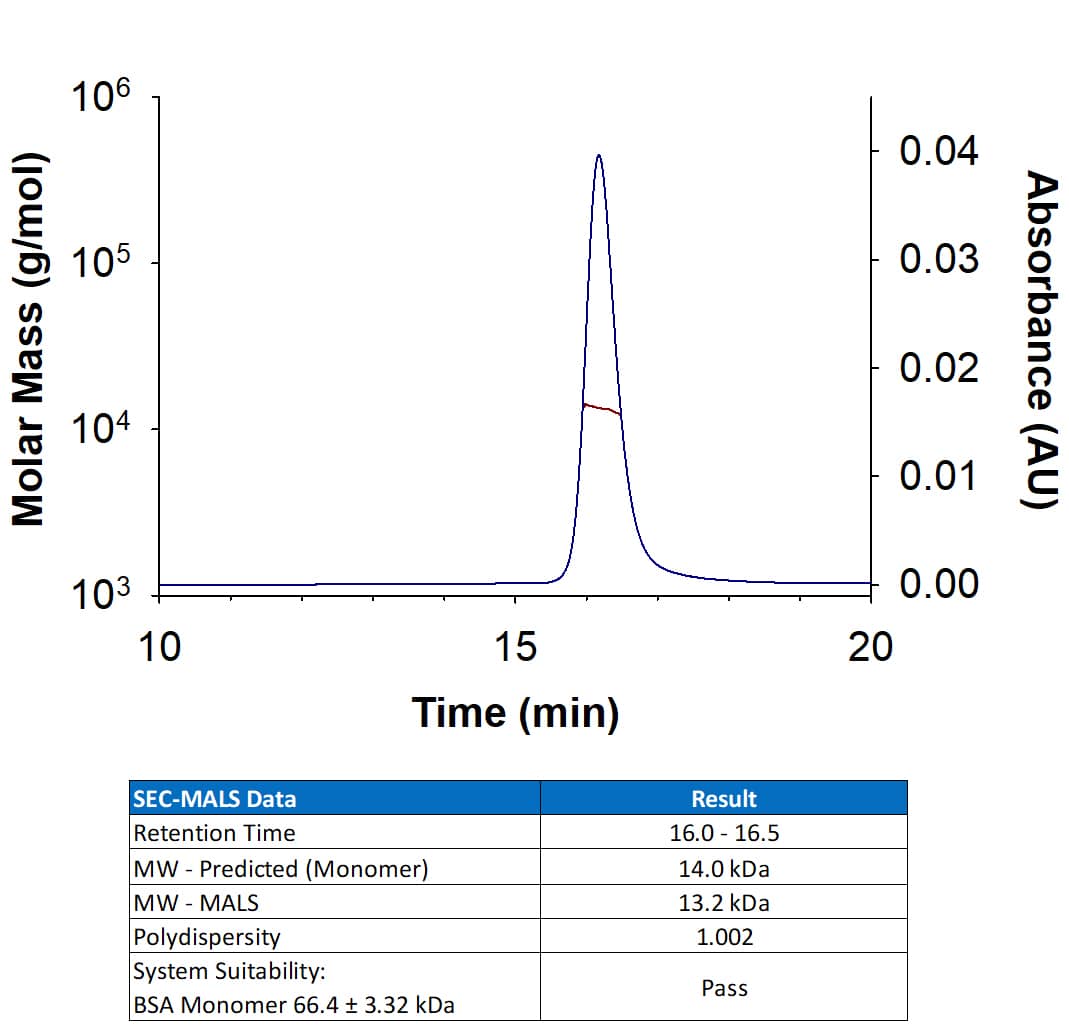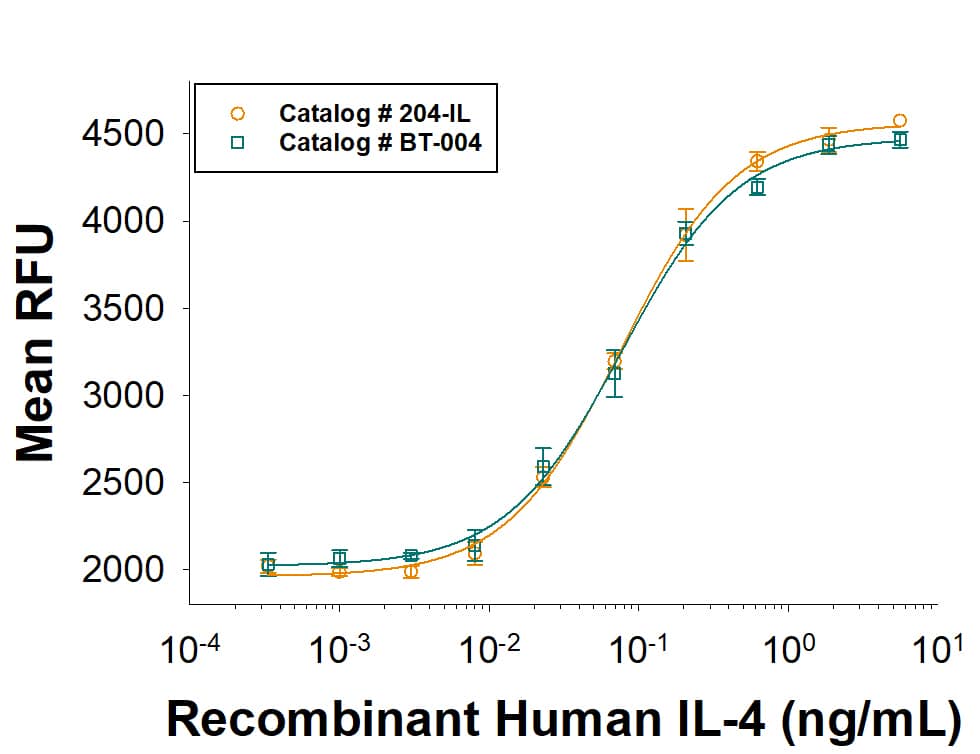IL-4: Proteins and Enzymes
IL-4 (Interleukin-4) is a cytokine that is primarily expressed by Th2-biased CD4+ T cells, mast cells, basophils, and eosinophils. It promotes cell proliferation, survival, and immunoglobulin class switch to IgG4 and IgE in human B cells, acquisition of the Th2 phenotype by naïve CD4+ T cells, priming and chemotaxis of mast cells, eosinophils, and basophils, and the proliferation and activation of epithelial cells. IL-4 plays a dominant role in the development of allergic inflammation and asthma. The type I receptor for IL-4, which is expressed on hematopoietic cells, is a heterodimer of the ligand binding IL-4 R alpha and the common gamma chain (a shared subunit of the receptors for IL-2, -7, -9, -15, and -21). The type II receptor on nonhematopoietic cells consists of IL-4 R alpha and IL-13 R alpha 1. The type II receptor also transduces IL-13 mediated signals.
20 results for "IL-4 Proteins and Enzymes" in Products
20 results for "IL-4 Proteins and Enzymes" in Products
IL-4: Proteins and Enzymes
IL-4 (Interleukin-4) is a cytokine that is primarily expressed by Th2-biased CD4+ T cells, mast cells, basophils, and eosinophils. It promotes cell proliferation, survival, and immunoglobulin class switch to IgG4 and IgE in human B cells, acquisition of the Th2 phenotype by naïve CD4+ T cells, priming and chemotaxis of mast cells, eosinophils, and basophils, and the proliferation and activation of epithelial cells. IL-4 plays a dominant role in the development of allergic inflammation and asthma. The type I receptor for IL-4, which is expressed on hematopoietic cells, is a heterodimer of the ligand binding IL-4 R alpha and the common gamma chain (a shared subunit of the receptors for IL-2, -7, -9, -15, and -21). The type II receptor on nonhematopoietic cells consists of IL-4 R alpha and IL-13 R alpha 1. The type II receptor also transduces IL-13 mediated signals.
| Source: | E. coli |
| Accession #: | P07750 |
| Applications: | BA |
Analyzed by SEC-MALS
| Source: | E. coli |
| Accession #: | P05112.1 |
| Applications: | BA |
Intended for preclinical researchers who may transition to GMP IL-4 for their clinical work, Analyzed by SEC-MALS
| Source: | E. coli |
| Accession #: | P05112.1 |
| Applications: | BA |
| Source: | E. coli |
| Accession #: | P05112.1 |
| Applications: | BA |
| Source: | CHO |
| Accession #: | P05112 |
| Applications: | BA |
| Source: | E. coli |
| Accession #: | AAD11563 |
| Applications: | BA |
| Source: | E. coli |
| Accession #: | Q04745 |
| Applications: | BA |
| Source: | E. coli |
| Accession #: | P20096.2 |
| Applications: | BA |
| Source: | E. coli |
| Accession #: | NP_001075988 |
| Applications: | BA |
| Source: | E. coli |
| Accession #: | P51492 |
| Applications: | BA |
| Source: | E. coli |
| Accession #: | P30367.2 |
| Applications: | BA |
| Source: | E. coli |
| Accession #: | P55030 |
| Applications: | BA |
| Source: | E. coli |
| Accession #: | NP_001156649 |
| Applications: | BA |
| Source: | E. coli |
| Accession #: | AAL18820 |
| Applications: | BA |
| Applications: | PAGE, Bioactivity |
| Applications: | PAGE, Bioactivity |
| Applications: | PAGE, Bioactivity |
| Applications: | PAGE, Bioactivity |
| Applications: | PAGE, Bioactivity |
| Source: | E. coli |
| Accession #: | P05112 |
| Applications: | BA |








![SDS-PAGE: Recombinant Human IL-4 His Protein [NBC1-22613] SDS-PAGE: Recombinant Human IL-4 His Protein [NBC1-22613]](https://resources.bio-techne.com/images/products/Recombinant-Human-IL-4-His-Protein-SDS-Page-NBC1-22613-img0003.jpg)
![SDS-PAGE: Recombinant Rat IL-4 Protein [NBP2-35252] SDS-PAGE: Recombinant Rat IL-4 Protein [NBP2-35252]](https://resources.bio-techne.com/images/products/Rat-IL-4-Protein-SDS-Page-NBP2-35252-img0001.jpg)
![SDS-PAGE: Recombinant Human IL-4 Protein [NBP2-34896] SDS-PAGE: Recombinant Human IL-4 Protein [NBP2-34896]](https://resources.bio-techne.com/images/products/Human-IL-4-Protein-SDS-Page-NBP2-34896-img0001.jpg)
![SDS-PAGE: Recombinant Mouse IL-4 Protein [NBP2-35131] SDS-PAGE: Recombinant Mouse IL-4 Protein [NBP2-35131]](https://resources.bio-techne.com/images/products/Mouse-IL-4-Protein-SDS-Page-NBP2-35131-img0001.jpg)
![SDS-PAGE: Recombinant Rhesus Macaque IL-4 Protein [NBP2-35309] SDS-PAGE: Recombinant Rhesus Macaque IL-4 Protein [NBP2-35309]](https://resources.bio-techne.com/images/products/Primate-IL-4-Protein-SDS-Page-NBP2-35309-img0001.jpg)
